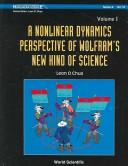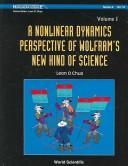| Listing 1 - 8 of 8 |
Sort by
|

ISBN: 1281930113 9786611930110 9812778896 9789812778895 9812569774 9789812569776 9812569766 9789812569769 9789812837936 9812837930 9789814317306 9814317306 9789814390514 9814390518 9789814460873 9814460877 9812566422 9789812566423 9781281930118 Year: 2007 Volume: v. 57 Publisher: Singapore New Jersey World Scientific
Abstract | Keywords | Export | Availability | Bookmark
 Loading...
Loading...Choose an application
- Reference Manager
- EndNote
- RefWorks (Direct export to RefWorks)
This novel book introduces cellular automata from a rigorous nonlinear dynamics perspective. It supplies the missing link between nonlinear differential and difference equations to discrete symbolic analysis. A surprisingly useful interpretations of cellular automata in terms of neural networks is also given. The book provides a scientifically sound and original analysis, and classifications of the empirical results presented in Wolfram's monumental "New Kind of Science."
Cellular automata. --- Computational complexity. --- Dynamics. --- Nonlinear theories. --- Wolfram, Stephen, --- Wolfram, Stephen.

ISBN: 9812772138 9789812772138 9789812569776 9812566422 9812569774 Year: 2006 Publisher: Singapore Hackensack, N.J. World Scientific Pub. Co.
Abstract | Keywords | Export | Availability | Bookmark
 Loading...
Loading...Choose an application
- Reference Manager
- EndNote
- RefWorks (Direct export to RefWorks)
This novel book introduces cellular automata from a rigorous nonlinear dynamics perspective. It supplies the missing link between nonlinear differential and difference equations to discrete symbolic analysis. A surprisingly useful interpretations of cellular automata in terms of neural networks is also given. The book provides a scientifically sound and original analysis, and classifications of the empirical results presented in Wolfram's monumental "New Kind of Science."
Cellular automata. --- Computational complexity. --- Dynamics. --- Nonlinear theories. --- Wolfram, Stephen, --- Wolfram, Stephen.

ISBN: 1282757539 9786612757532 9812837949 9789812837943 9812569774 9789812569776 9812569766 9789812569769 9789812837936 9812837930 9812566422 9789812566423 9781282757530 Year: 2009 Publisher: Hackensack, N.J. World Scientific
Abstract | Keywords | Export | Availability | Bookmark
 Loading...
Loading...Choose an application
- Reference Manager
- EndNote
- RefWorks (Direct export to RefWorks)
Volume III continues the author's quest for developing a pedagogical, self-contained, yet rigorous analytical theory of 1-D cellular automata via a nonlinear dynamics perspective. Using carefully conceived and illuminating color graphics, the global dynamical behaviors of the 50 (out of 256) local rules that have not yet been covered in Volumes I and II are exposed via their stunningly revealing basin tree diagrams. The Bernoulli στ-shift dynamics discovered in Volume II is generalized to hold for all 50 (or 18 globally equivalent) local rules via complex and hyper Bernoulli wave dynamics. E
Cellular automata. --- Computational complexity. --- Dynamics. --- Nonlinear theories. --- Wolfram, Stephen, --- Wolfram, Stephen.
Book
ISBN: 1283234718 9786613234711 9814317314 9789814317313 9789814317306 9814317306 Year: 2011 Publisher: Hackensack, N.J. World Scientific
Abstract | Keywords | Export | Availability | Bookmark
 Loading...
Loading...Choose an application
- Reference Manager
- EndNote
- RefWorks (Direct export to RefWorks)
Volume IV continues the author's odyssey on l-D cellular automata as chronicled in Volumes I, II and III, by uncovering a novel quasi-ergodicity phenomenon involving orbits meandering among omega-limit orbits of complex (group 5) and hyper (group 6) Bernoulli rules. This discovery is embellished with analytical formulas characterizing the fractal properties of characteristic functions, as well as explicit formulas for generating colorful and pedagogically revealing isomorphic basin tree diagrams. Many new results were derived and proved by uncovering subtle symmetries endowed by various subset
Cellular automata. --- Computational complexity. --- Dynamics. --- Nonlinear theories. --- Wolfram, Stephen,
Book
Year: 2012 Publisher: Washington : U.S. G.P.O.,
Abstract | Keywords | Export | Availability | Bookmark
 Loading...
Loading...Choose an application
- Reference Manager
- EndNote
- RefWorks (Direct export to RefWorks)
Cellular automata. --- Computational complexity. --- Science and state --- Wolfram, Stephen. --- United States.

ISBN: 9814390526 9789814390521 9814390518 9789814390514 9812569774 9789812569776 9812569766 9789812569769 9789812837936 9812837930 9789814317306 9814317306 9789814460873 9814460877 9812566422 9789812566423 Year: 2012 Publisher: New Jersey
Abstract | Keywords | Export | Availability | Bookmark
 Loading...
Loading...Choose an application
- Reference Manager
- EndNote
- RefWorks (Direct export to RefWorks)
This penultimate volume contains numerous original, elegant, and surprising results in 1-dimensional cellular automata. Perhaps the most exciting, if not shocking, new result is the discovery that only 82 local rules, out of 256, suffice to predict the time evolution of any of the remaining 174 local rules from an arbitrary initial bit-string configuration. This is contrary to the well-known folklore that 256 local rules are necessary, leading to the new concept of quasi-global equivalence . Another surprising result is the introduction of a simple, yet explicit, infinite bit string called the
Cellular automata. --- Computational complexity. --- Dynamics. --- Nonlinear theories. --- Nonlinear problems --- Nonlinearity (Mathematics) --- Calculus --- Mathematical analysis --- Mathematical physics --- Dynamical systems --- Kinetics --- Mathematics --- Mechanics, Analytic --- Force and energy --- Mechanics --- Physics --- Statics --- Complexity, Computational --- Electronic data processing --- Machine theory --- Computers, Iterative circuit --- Iterative circuit computers --- Structures, Tessellation (Automata) --- Tessellation structures (Automata) --- Parallel processing (Electronic computers) --- Pattern recognition systems --- Sequential machine theory --- Wolfram, Stephen. --- Wolfram, Stephen,
Book
ISBN: 9814460885 9789814460880 9789814460873 Year: 2013 Publisher: Singapore Hackensack, N.J. World Scientific
Abstract | Keywords | Export | Availability | Bookmark
 Loading...
Loading...Choose an application
- Reference Manager
- EndNote
- RefWorks (Direct export to RefWorks)
This invaluable volume ends the quest to uncover the secret recipes for predicting the long-term evolution of a ring of identical elementary cells where the binary state of each cell during each generation of an attractor (i.e. after the transients had disappeared) is determined uniquely by the state of its left and right neighbors in the previous generation, as decreed by one of 256 truth tables. As befitting the contents aimed at school children, it was found pedagogically appealing to code each truth table by coloring each of the 8 vertices of a cubical graph in red (for binary state 1), or
Cellular automata. --- Computational complexity. --- Dynamics. --- Nonlinear theories. --- Nonlinear problems --- Nonlinearity (Mathematics) --- Calculus --- Mathematical analysis --- Mathematical physics --- Dynamical systems --- Kinetics --- Mathematics --- Mechanics, Analytic --- Force and energy --- Mechanics --- Physics --- Statics --- Complexity, Computational --- Electronic data processing --- Machine theory --- Computers, Iterative circuit --- Iterative circuit computers --- Structures, Tessellation (Automata) --- Tessellation structures (Automata) --- Parallel processing (Electronic computers) --- Pattern recognition systems --- Sequential machine theory --- Wolfram, Stephen. --- Wolfram, Stephen, --- Electronic books. --- Books in machine-readable form --- Digital books --- E-books --- Ebooks --- Online books --- Books --- Electronic publications --- Wolfram, S.
Book
ISBN: 9782711858040 2711858049 Year: 2011 Publisher: Paris: Réunion des musées nationaux,
Abstract | Keywords | Export | Availability | Bookmark
 Loading...
Loading...Choose an application
- Reference Manager
- EndNote
- RefWorks (Direct export to RefWorks)
Les disciplines scientifiques et littéraires sont généralement perçues dans ce qui les différencie, les divise et parfois même les oppose. Pensée scientifique et pensée poétique s’expriment dans des modes de discours bien distincts. Il arrive pourtant qu’elles se rejoignent : c’est quand la pensée ne peut plus s’exprimer dans le mode qui lui était propre et que, recourant à une mise en forme directe, elle grave dans un schéma – du plus simple au plus complexe – le chemin qui la ramènera vers la parole. On dit bien souvent : « une image vaut 100 000 mots » ou bien encore, plus familièrement : « je fais vous faire un dessin" . Parmi les « auteurs » nous retrouvons Goethe, Darwin, Leibnitz, Freud, P. Valery, W. Benjamin, J. Malaurie, C. Simon, F. Lang, I. Nabokov, R. Queneau, un schéma présentant Internet…
Thought and thinking in art --- Thought and thinking --- Drawing --- Pensée dans l'art --- Pensée --- Dessin --- Psychological aspects --- Aspect psychologique --- Sémiologie de l'image --- Sémiologie --- Croquis --- Processus de conception --- kunst --- tekenkunst --- schetsen --- ontwerp --- kunst en wetenschap --- Agassiz Jean Louis Rodolphe --- Averty Jean-Christophe --- Axelos Kostas --- Barr Alfred H. --- Belyj Andrej --- Benjamin Walter --- kunst en filosofie --- kunst en literatuur --- Beuys Joseph --- Cache Bernard --- Cunningham Merce --- Czapski Joseph --- Darwin Charles --- De Jonckheere Philippe --- Descartes René --- Dreyfus Alfred --- Fischli Peter --- Florenski Pavel --- Freud Sigmund --- Geve Thomas --- Goethe Johann Wolfgang --- Gould Augustus Addison --- Griaule Marcel --- Hirschhorn Thomas --- Hundertwasser Friedensreich --- Itten Johannes --- Kahn Louis I. --- Kentridge William --- Klee Paul --- Klucis Gustav --- Korzyksbi Alfred --- Lang Fritz --- Langlois Henri --- Lombardi Mark --- Malaurie Jean --- Marinetti Filippo Tommaso --- Martin Etienne --- Mendeleïev Dimitri --- de Montgolfier Jospeh Michel --- Nabokov Vladimir --- Nelson Theodor H. --- Ogotemmêli --- Otlet Paul --- Pairault Pierre --- Perec Georges --- Queneau Raymond --- Rekacewicz Philippe --- Rice Peter --- Ricoeur Paul --- Simon Claude --- Steiner Rudolf --- Steinweg Marcus --- Strickland Hugh E. --- Valéry Paul --- Vertov Dziga --- Vig Lars --- Villani Cedric --- Weiss David --- Wolfram Stephen --- Wul Stefan --- Xenakis Iannis --- Zanzotto Andrea --- 741.03 --- 741.036 --- Pensée dans l'art --- Pensée --- Barr Alfred H --- Kahn Louis I --- Nelson Theodor H --- Strickland Hugh E --- Mind --- Thinking --- Thoughts --- Educational psychology --- Philosophy --- Psychology --- Intellect --- Logic --- Perception --- Psycholinguistics --- Self --- Art
| Listing 1 - 8 of 8 |
Sort by
|

 Search
Search Feedback
Feedback About UniCat
About UniCat  Help
Help News
News